GPC–IR Hyphenated Technology to Characterize Copolymers and to Deformulate Complex Polymer Mixtures in Polymer-Related Industries
Liquid chromatography–mid infrared spectroscopy (LC-IR) is a powerful tool for copolymer analysis. This article describes an automated, self-regulating solvent-removal interface that produces continuous transmission spectra from the deposited, solvent-free, solid-phase chromatogram.
Liquid chromatography–mid infrared spectroscopy (LC-IR) is a powerful tool for copolymer analysis. This article describes an automated, self-regulating solvent-removal interface that produces continuous transmission spectra from the deposited, solvent-free, solid-phase chromatogram.
Mid-infrared spectroscopy is a well established analytical technique to characterize the chemical composition of copolymers and their mixtures (1). When combined with a separation process, IR spectroscopic detection can provide characterization across a molecular size distribution (gel permeation chromatography [GPC] or size exclusion chromatography [SEC]), a chemical separation (liquid chromatography [LC]), a crystallization temperature distribution (temperature rising elution fractionation [TREF]), field-flow fractionation (FFF), or other separation process. These processes all require very significant dilution of the polymer to achieve the separation. For solubility, the solvents are generally chemically similar to the polymers and usually contain some of the same molecular bonds as the sample. The solvent molecules are in much higher concentration because of the high degree of dilution. To achieve sensitive, full mid-IR spectroscopy of the analytes, the solvent must be removed.
Hyphenated systems refer to the on-line real-time coupling of a powerful, typically physical, separation technique with a superficially incompatible high-information-content technique, most likely a spectroscopic analytical technique. The "hyphen" refers to the process and hardware used to make these techniques compatible, and it turns the entire hyphenated system into a single instrument. A single analysis by a hyphenated instrument produces more and higher quality information in minutes or hours rather than in the days or months required by tedious fraction collection, processing, and off-line analysis. Often sample degradation, handling losses, and contamination preclude the possibility of manually producing these data. By first separating the discrete chemical compounds or creating a continuous copolymeric distribution, the spectroscopic instrument provides more specific information with greater sensitivity and precision, especially about minor components.
To achieve a useful LC–IR instrument that produces full mid-IR spectra, the hyphenation process must
- remove the solvent without thermally damaging the analytes or overloading the system with diluent gas
- have efficient transmission of analytes to the spectrometer
- present analytes to the Fourier-transform infrared (FT-IR) system in a geometry that maximizes optical absorptivity (relatively thick concentrated deposit of small diameter)
- preserve the chromatographic resolution.
LC–IR Description and Operation
The LC–IR system used for the application cases presented in this article employs a novel hyphenated solvent-removal interface (Spectra Analysis Instruments, Inc., Marlborough, Massachusetts). This small-scale spray drier preserves temporal resolution while desolvating the liquid chromatography eluent (2). The resulting aerosol stream of dried solute is deposited onto a slowly rotating disk for continuous transmission IR spectrographic analysis. The solvent removal, deposition, and FT-IR instrument used for the following application examples is described in detail in reference 2.
GPC-IR Hyphenated Technology to Characterize Copolymers and Polymer Mixtures
A polymer is a mixture of many large molecules composed of repeating structural units with different polymer chain lengths or molecular weights. Polymers that contain only a single type of repeat unit (A) are known as homopolymers (PolyA), while polymers containing a mixture of repeat units (A, B, C . . .) are known as copolymers — for example, Poly(A-B). Polymer properties are strongly dependent on types of the repeat units, their arrangement along the polymer chains, their interactions between the polymer chains, and the chain length or molecular weight distributions. The polymer chain length or size strongly affects physical properties such as melting point, melt viscosity, glass transition temperature, strength, and impact resistance. For copolymers, the arrangement of repeat units along the polymer chain (for example, randomly, through blocks, or via grafting) will have great effects on polymer properties, which gives polymer scientists and engineers great freedom to design unique copolymer architecture and tailor polymer properties for various applications. To understand the correlation between copolymer structure at the polymer chain level and polymer material properties for field applications, there is a strong need to characterize the copolymer structural compositions at different polymer chain lengths across molecular weight (MW) distributions. The GPC–IR hyphenated technique combines physical separation of molecule hydrodynamic sizes by GPC or SEC with chemical composition fingerprinting by FT-IR. It takes snapshot IR pictures of copolymers or polymer mixtures for chemical compositions at each moleculer weight slice to map out polymer compositional variations across the whole MW distribution (MWD), which can be visualized as a 3D plot (2), as shown in Figure 6.
Figure 1 illustrates how GPC-IR characterizes the compositional variations of Poly(A-B) copolymer across MWD and its comparison with other analytical techniques. GPC separates the Poly(A-B) molecules on the basis of their molecular sizes, and FT-IR continuously fingerprints the chemical composition after eluent desolvation at each molar mass slice (correlated to GPC elution time). The characteristic IR peaks contributed from comonomers A and B can be easily calculated for A/B ratios across the MWD to map out the compositional variations as shown in the multicolor curve. When the same sample is analyzed by regular benchtop FT-IR or nuclear magnetic resonance (NMR) spectroscopy, only bulk average 50%A will be obtained. Mass spectrometry (MS) is limited to evaluation of the low MW portion of the polymer sample.
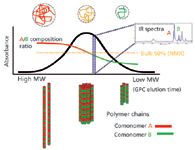
Figure 1: GPCâIR to characterize compositional variations (A/B ratios) of copolymer Poly(A-B) across MW distributions. NMR or regular benchtop FT-IR analysis gives only bulk average (50% A).
Copolymers and polymer mixtures are popularly used in many industries from chemical, materials, pharmaceutical, personal care, transportation, semiconductor, and energy, to nanotechnology in the forms of plastics, coatings, adhesives, sealants, elastomers, inks, films, foams, fibers, biopolymers, and composites. The following sections describe a few case studies of GPC–IR applications in the polymer related industries.
Characterizing Compositional Variations of Styrene–Butadiene Copolymers
An important aspect of copolymer synthesis that must be managed is composition drift, a variation of the relative amounts of comonomer species incorporated into the growing polymer chains during polymerization. Small variations in the concentration of comonomers in the reaction environment or any difference in monomer reactivities will generate composition drift during synthesis. The synthesis process must incorporate controls to either reduce composition drift or tailor it to a profile that yields the desired finished product properties.
Composition drift is inherent in the synthesis of many copolymers. Copolymer product properties can be controlled and optimized by controlling composition drift characteristics. The ability to characterize composition drift can greatly aid polymer manufacturers, processors, and end-users.
GPC–IR is used here to characterize compositional variations of styrene–butadiene copolymer, with a bulk average 10% styrene (3). Such materials are blended with polystyrene to form polymer alloy products with improved impact resistance and toughness that can be affected by copolymer compositional drift. The sample was dissolved in THF and was injected into a 50 cm × 1 cm Jordi-Gel mixed-bed linear DVB column (Jordi Labs LLC, Bellingham, Massachusetts) with tetrahydrofuran mobile phase. The GPC–IR hyphenated system removed the tetrahydrofuran solvent from the column eluent, deposited a polymer track, and immediately scanned to generate a time-ordered set of IR spectra as a function of polymer molecular weights. Functional group chromatograms were generated by scanning the data set along the time axis for the selected infrared bands: 1495 cm-1 for comonomer styrene (red) and 968 cm-1 for butadiene (green), as shown in Figure 2 (bottom). By dividing a styrene band chromatogram with a butadiene band chromatogram, the computer software generates a ratio chromatogram (black 1495 cm-1/968 cm-1 in Figure 2) of the styrene/butadiene compositional ratio across the chromatography elution profile (in other words, the molecular weight distribution). The ratio chromatogram with the band chromatograms clearly indicated the compositional drifts of the styrene–butadiene copolymer sample across the MWD although its bulk average of styrene is 10%.
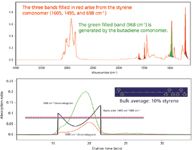
Figure 2: A snapshot GPCâIR spectrum (top) of a styrene-butadiene copolymer with red filled peaks from styrene comonomer and green filled from butadiene comonomer. The bottom plot shows the copolymer compositional variation across the MWD (GPC elution time) for comonomers styrene (red 1495 cm-1), butadiene (green 968 cm-1), and their ratios styrene/butadiene (black 1495 cm-1/968 cm-1).
Deformulation of Hot-Melt Adhesive
Hot-melt adhesive is one type of many industrial adhesives that are typically formulated with multiple polymer components with various additive packages to optimize overall properties for a given field application. The composition control of hot-melt adhesive products is key to optimizing the adhesive performance. This application case (4) shows how the GPC–IR hyphenated technique is used to deformulate complex polymer mixtures for competitive analysis, IP protection, contamination analysis, or process and product troubleshooting.
A sample of a hot-melt glue stick was dissolved in chloroform and analyzed by GPC–IR with a 50 cm × 1 cm Jordi-Gel mixed-bed linear DVB column with chloroform mobile phase. The "peak chromatogram" is shown at the top of Figure 3. This peak chromatogram provides universal detection by displaying the maximum absorbance at any wavenumber for every data point across the chromatogram. The elution profile shows a broad early elution peak (A) between 9 and 11.5 min, followed by what could be coeluents (B and C) around 12.5 min that are partially resolved.

Figure 3: GPCâIR peak chromatogram and band chromatogram (top) at 1724 cm-1 of hot-melt adhesive sample. Database search of the GPCâIR spectrum (bottom red) at 10-min elution time (A) matched up with a library standard IR spectrum (bottom green) of EVA copolymer.
The spectrum (Figure 3, in red) for the high-molecular-weight polymer A eluted at 10 min was database-searched for its identification. This spectrum shows a good spectral library match (Figure 3, in green) for ethylene–vinyl acetate copolymer. Further data processing showed stable ethylene/vinyl acetate comonomer ratios (no compositional drifts) across the MWD by ratioing the 2929-cm-1 CH2 peak and the 1724-cm-1 carbonyl peak from vinyl acetate (not shown).
The "doublet" peak at 12–13 min elution time in Figure 3 is suggestive of a pair of partially resolved components. IR functional group chromatograms can be very useful for clarification. Cursory inspection of spectra near the leading edge of the doublet (around 12 min) showed a pronounced absorbance at 1724 cm-1. A band chromatogram (time ordered sequence of absorbencies) at 1724 cm-1 (Figure 3) was extracted representing the concentration of carbonyl functionality across the chromatogram. Comparing this with the peak chromatogram, it is immediately apparent that the 1724-cm-1 band is not present in the late-eluted fraction of the doublet. Spectra at the leading and trailing shoulders of this double peak are displayed in Figure 4. These are two different materials displaying some coelution overlap. To deconvolve the spectra, a weighted intensity of the later elution spectrum at 12.73 min (aqua in Figure 4) was subtracted from the earlier elution spectrum at 12.42 min (blue in Figure 4) to obtain the red spectrum. The late-eluted resultant spectrum (aqua in Figure 4) contains entirely C-H bond absorption bands, typical of an alkane wax by database search. This spectral subtraction technique eliminated the artifacts of coelution and yielded clean spectra of the two discrete components. Spectral matching can be done on such samples by comparing sample spectra to known standards or to a spectral library that will automatically search for the most similar spectra from the library database. Comparison of the subtracted spectrum (red in Figure 4) to a spectral library provides a very good match to a glycerol rosin ester.
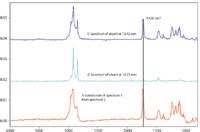
Figure 4: Spectral subtraction to resolve the GPC doublet peak (components B and C) of a hot-melt adhesive sample.
As a confirmation to the spectral matches, a set of the individual identified components were independently chromatographed under the same GPC conditions as shown in Figure 5. It can be seen that the elution times of these pure components match the elution peaks of the polymer mixture. The chromatogram elution times provide supporting evidence to the spectral matches obtained.
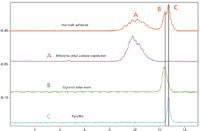
Figure 5: Spectral identification is supported by elution times of discrete standards: EVA copolymer (A), glycerol ester rosin (B), and paraffin (C).
These data illustrate the capability of GPC–IR to rapidly obtain identification of multicomponent polymeric materials. All data were collected during the course of a single GPC run and spectra from any part of the chromatograph can be examined for material identity. Therefore, GPC–IR provides an enormous gain in productivity when compared to the classical methods of preparative high performance liquid chromatography (HPLC) fraction collection and sample preparation of the many discrete fractions for spectral analysis. Some other successful deformulation cases include a complex polyolefin mixture of ethylene–propylene copolymer, ethylene–butene copolymer, and polypropylene; and a complicated mixture of hydroxypropyl methoxy cellulose (HPMC), hydroxypropyl cellulose (HPC), and povidone (PVP) with low-molecular weight additives.
Characterizing Polymeric Additives in Lubricant Oils
Both petroleum-based lubricants and synthetic lubricants contain additive packages that enhance functional performance of the lubricant oils. These additives serve a variety of functions, including corrosion protection, antioxidation, reduction of acidity, control of lubricant viscosity, detergency, and wear protection of metal surfaces. Viscosity index improver (VII) and the dispersant are both polymeric additives that typically comprise about 15% of the formulated lubricants. VIIs flatten out the viscosity–temperature curve of a lubricant. An engine oil provides optimum lubrication within a certain viscosity range and fails to provide this lubrication when it is too hot or too cold. Depletion of a VII or functional deterioration will result in increased engine wear. The use of VIIs extends the safe operating temperature range of motor oil. Dispersants interact with particulate material produced or ingested during engine operation, preventing agglomeration that results in sludge that coats internal engine surfaces and may plug oil passageways. The dispersants are complex small polymer chains that possess a polar chain-end group and an oil-philic end group. Polyisobutenyl succinimide and its variants are commonly used dispersants. Being polymeric materials, the VIIs and the dispersants are subject to shear degradation within an operating engine or other hydraulic applications that impose high liquid shear forces. A hyphenated GPC–IR method for identification and characterization of these polymeric components of lubricant oil (new and used) is described below (5).

Figure 6: 3D view of time-ordered spectra from the GPCâIR analysis of SAE 15W-40 heavy duty oil.
A sample of new Shell Rotella T SAE 15W-40 heavy duty oil for diesel engines (Shell Oil Company, Houston, Texas) was dissolved in tetrahydrofuran and was injected into a 25 cm × 1 cm Jordi mixed-bed linear DVB column with tetrahydrofuran mobile phase. To generate the GPC–IR chromatogram, the eluent was diverted after 12.2 min to prevent the lubricant fraction (low-MW base oil) from flowing on the collection disk and overrunning the deposited polymer fractions. The resultant IR chromatogram consequently does not have any of the base lubricant in the elution profile. Figure 6 provides a composite view of the spectral characteristics of the sample. The time-ordered spectra are stacked, with the earliest eluent in the foreground and the later eluent stretching into the background. The 3D view of the GPC–IR chromatogram shows a strong eluted peak at 9.2 min, followed by a broad elution band in the 10–12 min region with the unique chemical structures of the components. Figure 7 (top) is the snapshot IR spectrum of the initial elution peak at 9.2 min. This polymeric additive has an average molecular weight of 600,000 and is the viscosity index improver for this oil. Both aromatic ring (at 1601, 1493, and 698 cm-1) and ester functionalities (C=O 1735 cm-1 and C-O stretches in 1200–1000 cm-1) are apparent. Bands associated with conjugated dienes are absent. There is little apparent drift in the ratio of the 700-cm-1 and 1735-cm-1 bands of this elution peak, indicating minimal compositional variation. The spectra of this elution region appear to be those of a styrene–acrylate copolymer by database library search. The broad eluant profile in the 10–12 min elution timeframe provided a spectrum that is shown in Figure 7 (bottom). Spectral variation across this region in minimal and is indicative of a homogenous chemistry, with a broad variation of molecular weight (30,000–8000). This spectrum is characteristic of the dispersant polyisobutenyl succinimide (PIBS) by database library search. The broad elution profile of this material suggests a heterogeneity of molecular weight in this fraction, but no clear evidence of compositional drift in the comonomers. The dimethyl (1367 cm-1)/imide (1700 cm-1) ratio decreases by only about 10% across the elution range of 10.5–12.2 min.
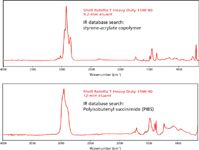
Figure 7: Snapshot IR spectra of the first additive elution peak (top) at 9.2 min and the second additive eluent fraction (bottom) at 12 min of motor oil lubricant.
GPC–IR Polymer Application Summary
Polymer developers and engineers have found great value in GPC–IR to characterize compositional variations of copolymers and polymer mixtures across the MWD in chemical, polymer, materials, and pharmaceutical industries. This information facilitates all aspects of copolymer invention, scale-up and commercialization by making it possible to
- characterize copolymer compositional–structural variations across MWD for lot-to-lot and supplier-to-supplier variations
- characterize any changes of copolymers and polymer mixtures from copolymer modification, degradation, failure analysis, and troubleshooting
- deformulate complex polymer mixtures of homopolymers and copolymers.
References
(1) J.L. Koenig, Spectroscopy of Polymers, second edition, (Elsevier Science Inc., New York, New York, 1999).
(2) W.W. Carson, M. Zhou, and T. Kearney, Recent Developments in HPLC/UHPLC, 50–58 (April 2011) http://chromatographyonline.findanalytichem.com/lcgc.
(3) Application Note 18, Copolymer Compositional Drift Measurement, Spectra Analysis Inc., Jan. 2008, www.spectra-analysis.com.
(4) Application Note 017, Characterization of a Hot-Melt Adhesive by LC-IR, Spectra Analysis Inc., Nov. 2007, www.spectra-analysis.com.
(5) Application Note 028, Lubricants Analysis, Spectra Analysis Inc., May 2008, www.spectra-analysis.com.
William W. Carson is senior vice president and Ming Zhou is director of application engineering at Spectra Analysis Instruments, Inc., in Marlborough, Massachusetts.
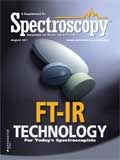
AI Shakes Up Spectroscopy as New Tools Reveal the Secret Life of Molecules
April 14th 2025A leading-edge review led by researchers at Oak Ridge National Laboratory and MIT explores how artificial intelligence is revolutionizing the study of molecular vibrations and phonon dynamics. From infrared and Raman spectroscopy to neutron and X-ray scattering, AI is transforming how scientists interpret vibrational spectra and predict material behaviors.
Real-Time Battery Health Tracking Using Fiber-Optic Sensors
April 9th 2025A new study by researchers from Palo Alto Research Center (PARC, a Xerox Company) and LG Chem Power presents a novel method for real-time battery monitoring using embedded fiber-optic sensors. This approach enhances state-of-charge (SOC) and state-of-health (SOH) estimations, potentially improving the efficiency and lifespan of lithium-ion batteries in electric vehicles (xEVs).
New Study Provides Insights into Chiral Smectic Phases
March 31st 2025Researchers from the Institute of Nuclear Physics Polish Academy of Sciences have unveiled new insights into the molecular arrangement of the 7HH6 compound’s smectic phases using X-ray diffraction (XRD) and infrared (IR) spectroscopy.